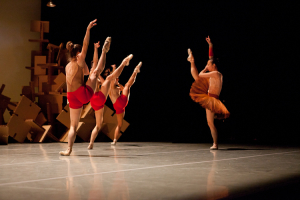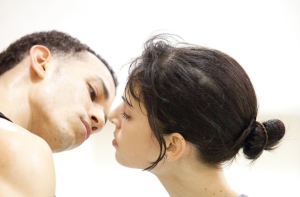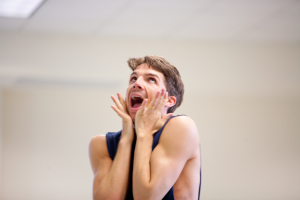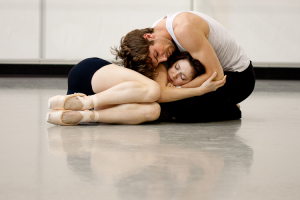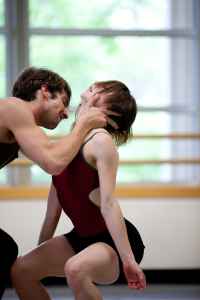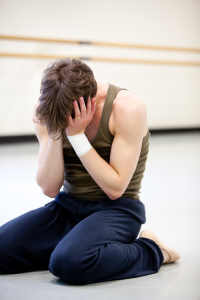If you’re a painter or sculptor, your viewer responds directly to the object you have made.
If you’re a writer, reader reaction, despite the intervention of the printed word, is still largely to your ideas as you set them down (though the degree to which that’s true is part of what drives the e-reader vs book debate).
But in the performing arts, an intermediate level of performer/interpreter profoundly influences, even determines, the experience of the audience.
A choreographer’s decisions about sound-movement-emotional coloration are made flesh by dancers, who add the complex layering, sparkle, intrigue and depth to which viewers respond. Nowhere is this truer than in a duet. Especially in works that draw on the classical ballet tradition, the emotional/aesthetic core of a piece is often rendered in dances for two.
The pas de deux is a particularly intense form in which the choreographer can study and reveal human interaction. It works because, along with the aesthetic pleasure viewers take from the dance, audience members connect to it via recognition of or identification with their own joys and sorrows. But a choreographer’s success in transmitting his/her insights or intentions is, as it were, at the mercy of the performers. Watchers must be drawn in to believe what is unfolding on the stage, which depends in turn on the individual nature of each dancer, the relation between them, and their joint ability to convince.
Fine dancers are able to call on something in their own life experience to give their portrayals emotional depth, whether they are portraying a conventional romantic relationship where both parties are in love, as in Sleeping Beauty; a classic pas de deux like Odile/Siegfried in Swan Lake or Giselle/Albrecht, where one is concealing something from the other; or one of the troubled connections depicted in the three parts of Olivier Wever’s three-part Monster, to be danced tonight and tomorrow (June 24-25 at 8 pm at Intiman Theatre) as part of Whim W’Him’s reSet program. The ability to use emotions felt in one context to inform the depiction of another is a lot like what fiction writers do. Emotional empathy, imagination, and versatility are essential. What I find fascinating about this whole process is the huge variety of ways in which dancers discover and access the needed feeling within themselves, as well as the diversity of relationships between dancers that can bring forth that essential spark.
A pas de deux engages the dancers in a unique type of interaction. For successful partnering, there must be a high level of trust between the two dancers. A case in point is Monster/ Relationship, as performed by Melody Herrera (the Houston Ballet principal who danced with Whim W’Him last January and will do so again this weekend) and Pacific Northwest Ballet principal Lucien Postlewaite. Melody remembers a college psychology course where she learned about a strong physical, hormonal bond between people who have undergone frightening or challenging or life-threatening experiences together. Very demanding pas de deux operate that way too, she says, psychically and corporeally. In an effective duet, the two dancers are in a highly interdependent situation, fraught with physical risk and emotional exposure. Viewing out of context isolated snapshots of the anguished expressions on the faces of Melody and Lucien, their taut muscles, the breathlessness and sweat, one could easily be forgiven for imagining that they are actually undergoing some terrible trial or crisis, not “just dancing.”
Melody and Lucien have a close history of working together, but that’s not the story being recounted in Monster/Relationship. Melody relishes dramatic roles, as does Lucien, who has said he loves being exposed emotionally on stage. She finds the role exhausting and hard, “but almost like therapy.” His thoroughly gay sensibility determines to whom he’s attracted sexually, yet it doesn’t prevent him from using complex and difficult experiences in his own earlier life from feeding his portrayal of a man in a complex and difficult relationship with a woman. That the woman in Monster/Relationship is Melody, who has had hard times in her own past to draw on, enormously enriches the range and depth of their dual portrayal of an abusive relationship monster, without it being any sort of statement about their own connection, which is easy, affectionate, and untroubled.
The relationship is quite different between Kylie Lewallen and Ty Alexander Cheng, who dance the Monster/Addiction pas de deux.
For some years they had an extremely close, romantic relationship offstage that manifestly fed their dancing—for example, in a sequence known as “The Kiss” in the 3Seasons Summer, first choreographed two plus years ago.
Since then they have separated. Private complications no longer so strongly muddy the waters, but their personal knowledge of each other arguably has made them dance better together. Kylie says: “You don’t have to juggle what’s happening in both places at once, and you don’t have to take it all home afterward,” while Ty talks about using intense emotions he felt in their particular relationship to fuel his dancing in Addiction. Although drug addiction itself is not part of their common past, certain feelings necessary to the depiction of a relationship marred by addiction—such as a sense of being not seen or being unable to connect—can be found in the fund of experience they do share. That history helps create the unique cold, crackling energy, like static electricity, of Addiction:
In the Monster/Society segment, Lucien emphasizes how much he has thrived on the opportunity for dancing a love pas de deux with another man (as he did in the Encore program at Pacific Northwest Ballet two weeks ago), a very uncommon experience for a classically trained and employed dancer. Andrew Bartee, his partner in some performances, though not those this weekend, concurs, while Andrew’s partner this time round, Victor Michael Lopez, very much likes the way the two men in Monster/Society are equals. Although the dance partnership in Society is not between real life partners in either of these pairings, each artist’s dancing is infused with a personal consciousness of indignities suffered because of sexual persuasion and brought to life by his own particular artistic sensibility and technical skill.
Interaction of the personal with the artistic/professional is a perennially beguiling subject. “Are they truly in love? Off-stage too?”
Curiosity, though too often merely nosy or prurient, can be based on genuine fascination with how art is made and taken in; with how, in other words, it works its magic. As the choreographer Frederick Ashton once said, “You always love the person you dance with for that moment, and something must emanate from you that communicates itself to the audience.”
Unless it is a pure exercise in form (in itself a rather dubious supposition when the medium is human bodies), a dance has meaning of some sort, transmitted to the viewer from two points of view—first, that of the choreographer who conceives it, and then, that of the dancers who give birth to it. Whether we make, perform or watch dance, we react to it through the veil or filter of our own lives. Out of what we have experienced, observed, heard, read or imagined, we form the impressions that determine if a piece has resonance for us (as choreographers, dancers or audience members) or if it remains alien or lifeless.
 When Margot Fonteyn and Rudolf Nureyev were dancing in the 1950s and ’60s (and even when they are mentioned now), the question always came up or hovered unspoken: did a physical love affair feed or even give rise to their captivating onstage romance. The question is, I think, naïve, and even in the end irrelevant. Not nearly enough credit is given, in our sex-obsessed country and era, to the many kinds of intense relationships that can exist outside of sex, including between pairs of people not of the gender that would in regular life be attracted to each other. What is really needed for a great pas de deux is two passionate people who call on personal experiences to nourish their dance and who know how to translate private awareness into public art.
When Margot Fonteyn and Rudolf Nureyev were dancing in the 1950s and ’60s (and even when they are mentioned now), the question always came up or hovered unspoken: did a physical love affair feed or even give rise to their captivating onstage romance. The question is, I think, naïve, and even in the end irrelevant. Not nearly enough credit is given, in our sex-obsessed country and era, to the many kinds of intense relationships that can exist outside of sex, including between pairs of people not of the gender that would in regular life be attracted to each other. What is really needed for a great pas de deux is two passionate people who call on personal experiences to nourish their dance and who know how to translate private awareness into public art.
